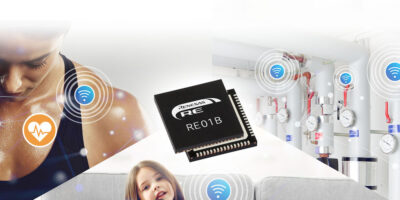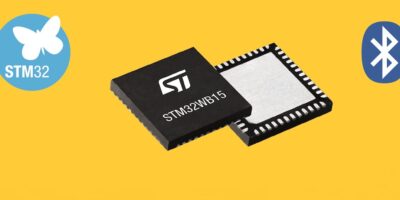The latest member of Renesas Electronics’ RE family of microcontroller is the RE01B, which has Bluetooth 5.0 support. The 32-bit low power microcontroller was developed using Renesas’ SOTB (Silicon on Thin Buried Oxide) process technology.
The Bluetooth-capable RE01B is suitable for energy harvesting systems and intelligent IoT devices that operate constantly at extremely low power levels without having to replace or recharge batteries. The RE01B microcontroller makes it easier to implement regular data management and firmware updates over Bluetooth while maintaining low power consumption, which extends the battery life.
The on-chip energy harvesting control circuit (rapid start up capacitor charging and secondary battery charge protection functionality) allows users to achieve battery-less Bluetooth communication. Energy harvesting and power storage can be directly connected to the RE01B.
The microcontroller is suitable for compact healthcare devices such as pulse oximeters and biomedical sensor patches, remote controls with voice recognition capabilities and smart meter modules. RE01B can also be used for IoT devices that require constant operation, period data collection and updates, such as devices for monitoring the elderly, children or assets in transit.
The RE01B is built around the Arm Cortex-M0+ core and Renesas’ proprietary SOTB process technology. It operates at a maximum operating frequency of 64MHz and achieves current consumption as low as 35 microA/MHz during operation and 600nA during standby; this is among the lowest in the industry for a Bluetooth-capable microcontroller, says Renesas. It can also be combined with Renesas’ ISL9123 ultra-low Iq DC/DC converter, configured as an external step-down regulator, to reduce current consumption during operation down to 15 microA/MHz to improve power efficiency.
It has 1.5Mbyte flash memory and 256Kbyte SRAM with Bluetooth functionality, suitable for over the air (OTA) firmware updating.
The RE01B is in a 64-pin QFN package measuring 8.0 x 8.0mm.
Security function include Trusted Secure IP and Renesas offers application programming interfaces (APIs) conforming to standard protocols, such as heart rate profile (HRP), environment sensing profile (ESP), and automation I/O profile (AIOP), in addition to Bluetooth 5.0 protocol stack.
Development tools for the RE family, include a QE for Bluetooth Low Energy, which generates programs for custom Bluetooth profiles that can then be integrated into the user’s own application programs, and a Bluetooth test tool suite, which provides a graphical user interface that allows users to perform initial wireless characteristics evaluations and Bluetooth functionality verification.
The RE01B is available now. The EB-RE01B evaluation kit from Tessera Technology is also available now.







